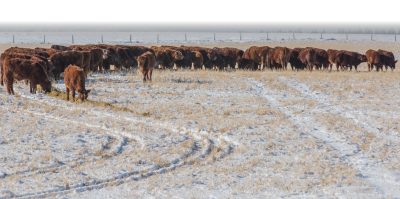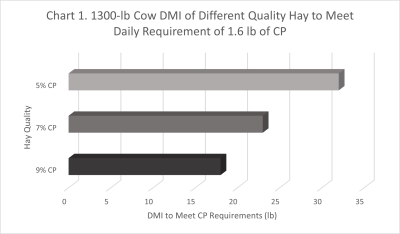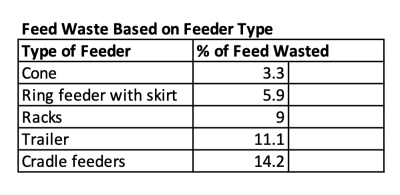As you wean calves and prepare for the fall and winter months, it is important to consider your herd’s nutritional requirements and ensure that livestock performance isn’t negatively impacted.
After weaning, fall is the best time to improve the body condition of thinner cows (Ziegler and Mulliniks, 2019). However, factors such as stress from cold temperatures, low quality forages (range forage, hay, etc.), and age can influence whether or not their nutritional requirements are met.

Stress from cold temperatures
Before winter, it is important to evaluate the body condition score (BCS) of your cattle to ensure they achieve a BCS of 5–5.5 prior to winter (Drewnoski and Wilke, 2019). Improving the BCS of your cattle prior to winter reduces the negative impact of cold weather on livestock performance. Cold temperatures add stress to cattle that increases their energy requirements. If energy requirements are not met, BCS may decrease.
BCS also influences lower critical temperature (LCT), the threshold at which cattle have to start using energy to maintain their body temperature (Drewnoski and Wilke, 2019). Cows in good condition (BCS 5–5.5), with dry heavy coats, can more easily maintain their body temperature without needing to use additional energy until the wind chill index is below 19oF. However, thinner cows with BCS of 4 and dry heavy coat have a LCT of 27oF.
Note that LCT increases significantly when cattle have a wet coat or if there is wind present. Make sure to provide wind protection and monitor your herd’s BCS over the fall and winter to ensure their energy requirements are fulfilled. If body condition starts to decrease, providing or increasing supplementation high in energy is recommended to satisfy increased energy demand.
Forage quality
As you prepare for feeding during the fall and winter months, it is important to understand the nutritive value of the forage that your livestock are consuming. Keep in mind that range native forages are dormant and have less forage value in the colder months compared to the growing season.
Hay testing is a useful tool in determining nutritive value. Testing annual forages and harvested annual forages for nitrates is also crucial because drought-stressed annual forages can cause nitrate toxicity. It is important to test your hay prior to feeding to ensure that it is safe for your livestock to consume and to determine if the nutritional requirements of your herd will be met or if supplementation is needed.
Feed quality
To determine if and what kind of supplementation is needed to meet nutritional requirements, you must know the quality of the feed your herd is consuming. When two feeds with different crude protein (CP) % are compared on a dry matter (DM) basis, it is important to understand what the percentage difference means in terms of dry matter intake (DMI).
An example from Greenwell (2020) demonstrates that a spring calving cow who weighs 1300 lbs and is currently in the second trimester (fall/early winter) needs 1.6 lbs of crude protein (CP). Therefore, if she were consuming 9% CP hay, her daily DM intake would have to be 17.8 lbs to meet her CP requirement, but if she consumes 5% CP hay, she would have to consume 32 lbs on a dry matter basis to meet the requirement (Chart 1 below) (Greenwell, 2020).

Knowing what affects cattle nutritional requirements is important when creating your fall-winter care management plan. Lower quality feed can be given to cattle with lower nutritional requirements, such as cattle in maintenance and cattle in the first trimester.
However, cattle still growing, lactating cows, cattle needing to increase their BCS, and cattle in the third trimester have higher nutritional requirements (Reynolds et. al., 2000) so it is better to give them higher quality feed. Separating cattle based on their nutritional requirements can help a producer better meet nutritional requirements while saving money.
Pregnancy checking cattle and heifers is extremely important as it helps you determine the number of open cattle you have. Culling older cows or open cows can help reduce the amount of feed needed this winter.
Additionally, if you want to retain open cattle, pregnancy checking allows you to separate bred and open cattle and feed them differently based on their nutritional requirements. Separating heifers from cows is beneficial not only because of the difference in nutritional requirements, but also because young heifers are not as aggressive and do not eat as rapidly as mature cows, which can make it harder for them to meet their intake needs.
Other things to consider
When buying and feeding hay this fall and winter, there a few additional things a producer should consider. When buying and feeding hay that may contain weeds or invasive grasses, minimize where you are feeding this hay to avoid spreading weeds and invasive grasses throughout a pasture.
While feeding hay, it is important to understand that some hay losses will occur. Producers spend approximately 26–40% of the cost of production on feed (Redfearn, 2017; Lalman, 20121). However, management techniques can reduce the amount of waste, which can reduce feed cost and increase the profitability of the herd (Tonn, 2016).
Research conducted by the University of Nebraska and Michigan State University showed that the type of feeder used can affect the amount of feed wasted (see Figure 2 below) (Tonn, 2016). Although some feeders are more expensive, feeding out of feeders that force the animal to turn its head when backing away from the feeder instead of being able to back straight out of the feeder reduces feed waste; this can make the extra cost worth it.
Feed loss can also be reduced by feeding daily only the amount of hay required per day as it forces your livestock to eat hay they might otherwise refuse and trample (Tonn, 2016).

While it might be difficult to remove and pick up every piece of bailing twine and hay wrap, do your best to prevent cattle from consuming it. A study conducted by North Dakota State University found that after 14 days, net wrap and biodegradable twine are not broken down in the rumen (Tonn, 2016; Anderson, 2017). Sisal twine is more digestible (70% digestibility), but still digested more slowly than hay (Tonn, 2016; Anderson, 2017).
A small amount of twine or net wrap in the rumen may not be a major issue, but consumption and accumulation of large amounts of twine/wrap can create major issues. Try to remove and pick up as much of the wrap and twine as possible to reduce impacts on your herd.
Finally, as temperatures start to fall, it is important that livestock have access to thawed water. This can be challenging throughout the winter but preparing for it now can have significant returns. Recommendations for how to provide thawed water include water tank heaters, heated tanks, and breaking ice multiple times as needed.
Summary
As you prepare for feeding your herd during the fall and winter months, keep in mind a few key considerations to increase livestock performance and reduce feed cost. It is extremely important to increase the BCS of your thin cows post weaning but prior to winter when cold stress increases their energy requirements.
Understanding your forage quality and how it affects daily intake can help ensure you are supplementing when needed to meet the nutritional requirements of your herd. Although feed waste and some hay wrap/twine consumption may occur, precautions to reduce feed waste and consumption of hay wrap/twine can improve profitability. Finally, it is important that livestock have access to thawed water during the winter months.
Sources for further information on fall-winter cattle care
Anderson. B., 2017. Remove Net Wrap and Twine. University of Nebraska Lincoln. https://newsroom.unl.edu/announce/beef/7288/41691
Drewnoski. M., and Wilke. K.H., 2019. Helping Cows Cope with Cold Stress. University of Nebraska Lincoln. https://beef.unl.edu/beefwatch/helping-cows-cope-cold-stress
Greenwell. H., 2020. Do You Know the Difference Between 9% and 7% Crude Protein Hay? University of Nebraska Lincoln. https://beef.unl.edu/beefwatch/2020/do-you-know-difference-between-9-and-7-crude-protein-hay
Lalman. D., 2021. Supplementing Beef Cows. Oklahoma State University. https://extension.okstate.edu/fact-sheets/supplementing-beef-cows.html
Redfearn. D.D., 2017. Reducing Winter Feeding Costs. Oklahoma State University. https://extension.okstate.edu/fact-sheets/reducing-winter-feeding-costs.html
Reynolds. D.A., Waggoner. J.W., and Smith. M.A., 2000. Cattle Management Manual. University of Wyoming. https://www.wyoextension.org/agpubs/pubs/MP-97.pdf
Tonn. S., 2016. Winter Hay Considerations. University of Nebraska Lincoln. https://newsroom.unl.edu/announce/beef/5899/33995
Ziegler. R., and Mulliniks. T., 2019. Tips to Improve Cow Performance While Consuming Low-quality Forages. University of Nebraska Lincoln. https://beef.unl.edu/beefwatch/tips-improve-cow-performance-while-consuming-low-quality-forages





